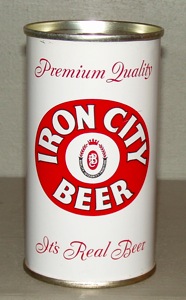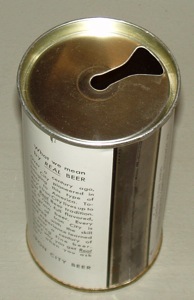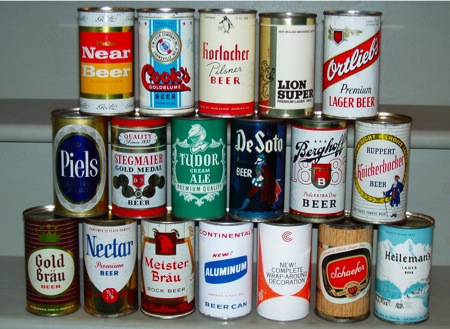
Beer Can Collecting
Yes, even writers have hobbies. Mine (one of mine) is collecting very old beer cans.
What follows is designed for two audiences, the first being the curious tourist, and the second, a potential seller––someone who has old cans and might consider selling them to me.
(If you’re an active beer can collector yourself, you presumably already know why you’re here. Enjoy the pictures!)
Beer cans first appeared in 1934, and by 1970, an organization had been formed to celebrate the collecting of these disposable containers. That organization is the Brewery Collectibles Club of America, and their web site is http://www.bcca.com/
What do I collect? Any beer can from Ohio, along with steel cans from Canada, Sweden, and the United Kingdom––especially 9 2/3 oz. British cans. Here are two photos covering about one quarter of what I currently have on display:
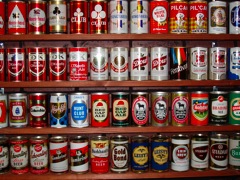

What do I hope to find?
Well, cone tops are always nice. Here are two cone tops, one low profile, one high. Low profile cones, like the Grain Belt can shown here, were produced prior to WW II, and are, as a general category, the most valuable and prized cans in the hobby. High profile cone tops, like the Bavarian’s shown below, were manufactured until the late nineteen fifties.
Note that in both cases, the cans are very shiny and clean despite their age. Metal cans don’t age well––which is what makes examples in this kind of condition so desirable.
Cone tops also appeared as quart-sized cans, and as “crowntainers,” where the body of the can melded into the spout without a top rim.
The other basic kinds of beer cans that I hope to acquire have flat tops (also called punch tops), zip tops, or pull tabs. Flat tops had to be opened with a can opener, or “church key.” Here are a few examples of flats, zips, and early pulls:
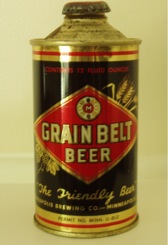

Note that some of these cans have been opened from the bottom! That’s always a nice touch. One of the flat tops has an Ohio tax stamp on the lid; the other, while also an Ohio can, does not. Laws––and times––change.
Is that rust on the Old Dutch ring pull? Yes. The can hails from about 1965, and I found it along the Clear Fork River near Mohican State Park, in Ohio. “Outdoor cans” rarely look as good as “indoor cans.” Here’s a photo showing two very valuable Canadian beer cans, but both are badly rusted––they are what can collectors call “dumpers.”
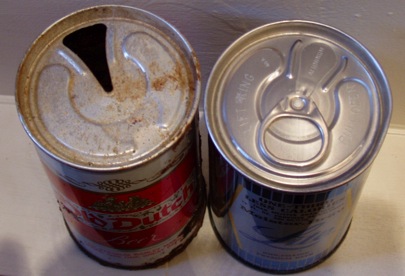

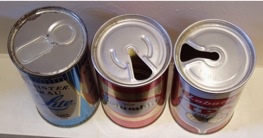

Click image to enlarge
Click images to enlarge
Click images to enlarge
Click images to enlarge



Believe it or not, these cans are part of my collection! They are the best examples I have been able to find of these particular labels without paying a tremendous amount of money. (In their current condition, I doubt I could muster more than five dollars for the pair.)
That said, I do buy collections, and I am always on the lookout for more. If you have any old cans––cans that match the tops I’ve shown above, for example––and they are in good condition, I would very much like to hear from you. You can email me at tracer@fgi.net.
I also buy individual cans, if they’re old and in good shape. Perhaps you were remodeling and a host of flat tops fell out of your wall? Perhaps Uncle Fred stashed cans in his attic and you just found them under the insulation? If so, I want to hear from you. No set of cans is too large or too small––it’s just a matter of age, condition, and relative rarity.
SPECIAL NOTE FOR ANYONE WITH A COLLECTION TO SELL
Beer can collecting was a major fad in the seventies and early eighties, and cans made during those years tend to be worth zilch, zip, nada, nothing. Why? Supply and demand. Collectors bought those cans by the caseload. Because of this, some supposedly valuable cans are essentially worthless. These include: Billy Beer, MASH 4077th, World’s Fair, all generic beers, and pretty much anything made of aluminum or crimped steel. (All of the cans pictured above are “SS,” or “straight steel,” where the edges of the can do not indent before meeting the top and bottom rims.) Beware also cans made especially for the collector’s market, such as Olde Frothingslosh, Andy’s, and the various “Brewery sets” from Huber.
Thanks for looking this over, and again, if you have old cans that are looking for a new home, I might very well be your buyer.
Please visit the rest of my site! After all, my real hobby is writing...
***
MORE PHOTOS
One of these rusty old eight ounce flat tops is worth hundreds of dollars.
Can you guess which?
This Iron City Beer is the world’s first self-opening beer can.
No, it didn’t do the work by itself, but prior to this can (released in 1962, and only test-marketed in Virginia), the would-be consumer had to use a can opener (frequently referred to as a church-key). Note the aluminum top with the Y-shaped opening: This is a classic zip top can––and in fabulous shape. Only a few of those are known, and this example now resides in a West Coast collection. I am humbled to have had it pass through my hands first!
Above: A Very Rare DeSoto Beer!
Some nice cans in this find! The fall of 2008 will definitely go down as a can collecting success as a result of these. Air-sealed flat tops one and all––presumably brewery samples? Since the cans assembled here represent several different canning companies, it’s not clear to me what links these cans as a group except that they all turned up in one place. Where?
Well, I got them by purchasing an ex-collector’s collection. Where’d he get them?
At a flea market! All at once.
Not pictured: One International Frankenmuth from Findlay that ended up on my shelf.
ADDITIONAL CAN COLLECTING LINKS:
